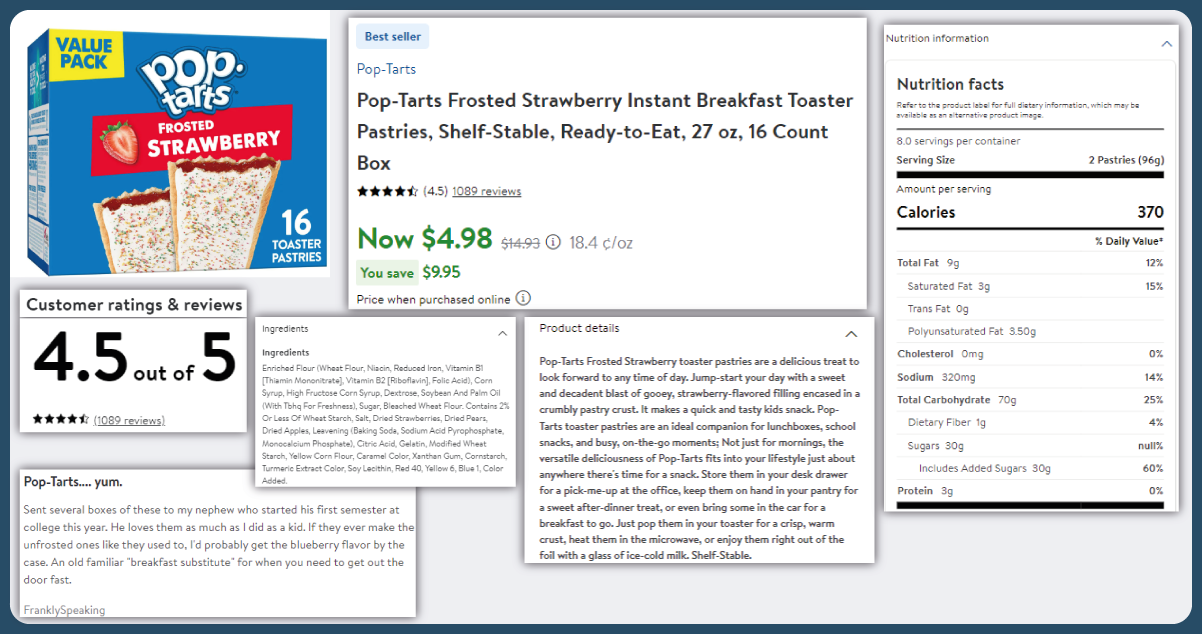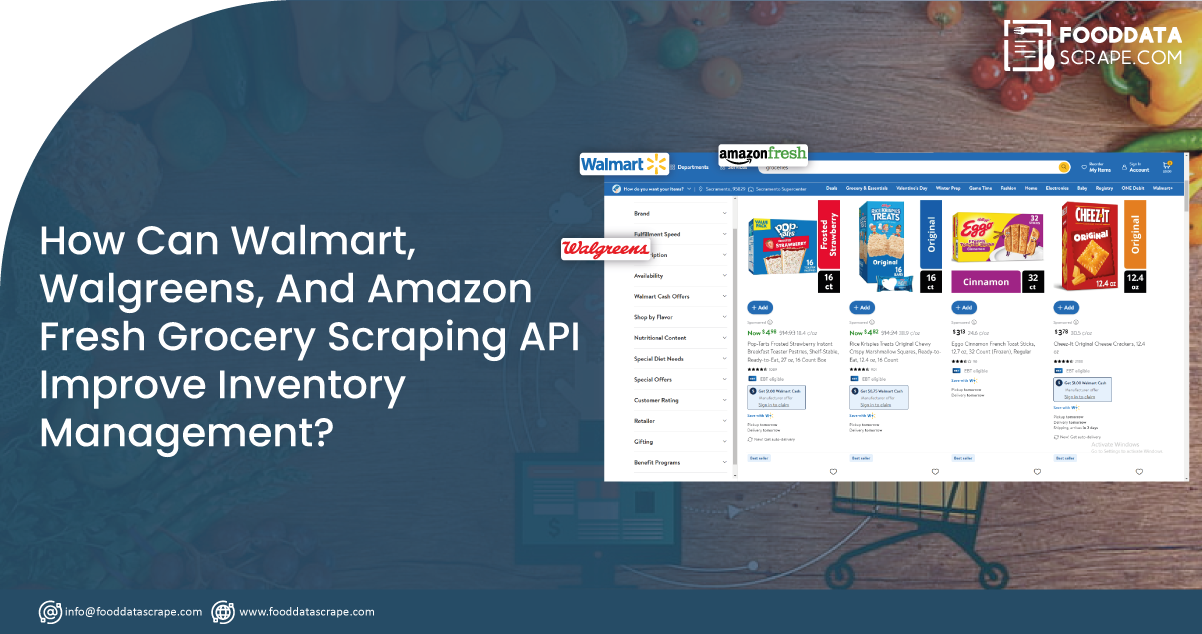Grocery data scraping revolutionizes retail by systematically extracting valuable information from online grocery platforms. This technique involves gathering comprehensive data on product details, prices, customer reviews, and inventory levels. Grocery data scraping empowers retailers with real-time insights, facilitating dynamic pricing strategies, inventory management, and competitive analysis. By harnessing this data, businesses can adapt swiftly to market trends, enhance customer experiences, and optimize their operations. In the ever-evolving grocery industry, data scraping emerges as a strategic tool, enabling retailers to stay competitive, make informed decisions, and provide a seamless shopping experience for consumers.
Grocery data scraping API revolutionizes the retail landscape by systematically extracting valuable information from online grocery platforms. This technique involves gathering comprehensive data on product details, prices, customer reviews, and inventory levels. Grocery data scraping services empower retailers with real-time insights, facilitating dynamic pricing strategies, inventory management, and competitive analysis. By harnessing this data, businesses can adapt swiftly to market trends, enhance customer experiences, and optimize their operations. In the ever-evolving grocery industry, data scraping emerges as a strategic tool, enabling retailers to stay competitive, make informed decisions, and provide a seamless shopping experience for consumers.
List of Data Fields

- Product Details: Names, descriptions, and specifications of grocery items.
- Pricing Information: It includes regular prices, discounts, and promotional offers.
- Customer Reviews: Feedback, ratings, and comments from customers.
- Inventory Levels: Availability status and stock quantities of various products.
- Brand Information: Details about the brands and manufacturers of grocery items.
- Category and Department Classification: How products are categorized and organized on the website.
- Nutritional Information: It includes nutritional facts and details for food items.
- Images and Visual Content: Product images, labels, and other visual content.
- Delivery and Shipping Information: Details about delivery options, shipping costs, and delivery times.
- Promotional and Seasonal Offers: Information on ongoing promotions, discounts, or seasonal offers.
- Customer Satisfaction Metrics: It helps aggregate data on customer satisfaction, ratings, and overall shopping experiences.
- Product Ratings: These include average ratings and reviews for individual products.
- Ingredient Lists: Detailed lists of ingredients for food items.
- Product Variants: It includes different sizes, flavors, or versions of the same product.
- Customer Preferences: Data indicating popular products, frequently purchased items and customer preferences.
- Website Structure and Navigation: Information on how products are organized and presented on the website.
- Specialty and Organic Labels: include identifying specialty or organic products through labeling.
- Product Availability Alerts: It possess notifications or indicators for out-of-stock or back-in-stock items.
List of Grocery Websites
Walmart: a global retail giant, Walmart is renowned for its vast array of products and services. Founded in 1962, it has grown into the world's largest retailer, operating in various formats, including supercenters, discount stores, and online platforms. Walmart's commitment to providing low prices, convenience, and a diverse product selection has made it a household name. With an expansive reach, innovative technologies, and a focus on sustainability, Walmart continues to shape the retail landscape and influence consumer experiences globally. Scrape Walmart product data to collect details on various products, prices, and customer reviews, providing valuable insights for market analysis and business strategies.

Walmart Grocery scraping API is instrumental for businesses, offering real-time access to a comprehensive dataset of grocery products, prices, and inventory information. This process facilitates market analysis, allowing retailers to discern trends, optimize pricing strategies, and enhance inventory management. By harnessing the Walmart Grocery API, businesses gain a competitive edge through informed decision-making. This scraping method proves invaluable in the dynamic grocery retail sector, empowering retailers to stay adaptable, responsive, and efficient in meeting consumer demands while maintaining a strategic position in the market.
Walgreens: Established in 1901, Walgreens is a prominent American pharmacy and retail company. With a vast network of stores, it provides pharmaceutical services, health and wellness products, and general merchandise. Known for convenience and accessibility, Walgreens offers prescription services, photo printing, beauty products, and household essentials. Its online platform extends its reach, allowing customers to shop from anywhere. Walgreens' commitment to community health, diverse offerings, and technological innovations has solidified its position as a trusted destination for various consumer needs in the United States and beyond. Scrape Walgreens product data to enable comprehensive insights into pharmaceuticals, health products, and merchandise. This extraction facilitates market analysis, pricing optimization, and strategic decision-making for businesses in the retail sector.

Walgreens grocery scraping API can help businesses leverage real-time product data, track pricing trends, and enhance market competitiveness. By accessing Walgreens grocery API, businesses can automate inventory management, monitor stock levels, and optimize pricing strategies. This scraping process enables timely updates on product availability, promotions, and customer preferences. Ultimately, it empowers businesses to make informed decisions, improve customer satisfaction, and stay ahead in the dynamic retail landscape. However, it is crucial to adhere to ethical scraping practices and comply with relevant terms of service to maintain a positive relationship with the data source.
Amazon Fresh: Amazon Fresh, a grocery delivery and pickup service by Amazon, offers a diverse selection of fresh produce, pantry staples, and household essentials. Launched in 2007, it provides customers the convenience of online grocery shopping and doorstep delivery. Integrating with Amazon Prime, Amazon Fresh enhances the shopping experience, allowing for quick deliveries and exclusive discounts. This service exemplifies Amazon's commitment to innovation in the retail sector, meeting evolving consumer needs by combining technology and convenience for a seamless online grocery shopping experience. Scrape Amazon Fresh product data to collect details on a wide range of grocery items, prices, and customer reviews, providing valuable insights for market analysis and business strategies. Harness the power of Amazon Fresh grocery scraping API to gain a competitive edge in the market. This scraping technique enables businesses to access real-time data on product availability, prices, and customer reviews. By automating the extraction of information, companies can streamline inventory management, optimize pricing strategies, and stay abreast of market trends. This data-driven approach facilitates informed decision-making, enhances customer satisfaction, and bolsters overall business efficiency. It is essential, however, to conduct scraping ethically, respecting terms of use, and fostering a positive relationship with the data source.

Steps Involved in Scraping Real-Time Grocery Data Using Walmart, Walgreens, and Amazon Fresh API

Research and Obtain API Keys: Acquire API keys from Walmart, Walgreens, and Amazon Fresh by registering as a developer on their respective developer platforms.
API Documentation Review: Thoroughly study the API documentation provided by each platform to understand endpoints, authentication methods, and data structures.
Set Up Environment: Create a development environment and install necessary libraries or frameworks for handling API requests and parsing data.
Authenticate and Connect: Implement authentication using the obtained API keys to establish secure connections with Walmart, Walgreens, and Amazon Fresh APIs.
Endpoint Requests: Develop scripts to send HTTP requests to relevant API endpoints, fetching real-time grocery data such as product details, prices, and availability.
Data Parsing: Parse the received JSON or XML responses to extract and structure the required information, ensuring compatibility with your application or database.
Error Handling and Rate Limiting: Implement robust error-handling mechanisms and adhere to rate limits imposed by each API to prevent disruptions and maintain compliance.
Data Storage and Analysis: Store the scraped data in a database for future analysis, reporting, and integration into your business processes. Regularly update the scraping process to ensure data accuracy and relevance.
Why Scrape Walmart, Walgreens, and Amazon Fresh Grocery Delivery Data?

Scraping grocery delivery data from Walmart, Walgreens, and Amazon Fresh offers businesses a strategic advantage in today's competitive market. Firstly, real-time data extraction provides immediate insights into product availability, pricing fluctuations, and customer preferences, enabling businesses to adapt swiftly to market dynamics. This timely information is crucial for maintaining optimal inventory levels and implementing agile pricing strategies, contributing to improved operational efficiency.
Secondly, scraping data from these major retailers allows businesses to conduct thorough market analysis. Understanding the product landscape, customer reviews, and promotional activities empowers companies to make informed decisions, identify emerging trends, and refine their offerings. It, in turn, enhances their competitiveness in the ever-evolving grocery sector.
Moreover, scraped data facilitates the development of targeted marketing strategies and personalized customer experiences. By gaining visibility into customer behavior and preferences, businesses can tailor their promotions, recommendations, and service offerings to meet the specific needs of their audience. It not only strengthens customer engagement but also fosters loyalty and satisfaction.
In essence, scraping grocery delivery data from Walmart, Walgreens, and Amazon Fresh is not merely a technical process; it is a strategic initiative that equips businesses with the intelligence needed to stay agile, competitive, and responsive to the demands of the dynamic retail landscape.
Conclusion: Walmart, Walgreens, and Amazon Fresh grocery scraping API is a transformative strategy that provides businesses with real-time insights crucial for agile decision-making. By harnessing this data, companies enhance inventory management, optimize pricing, and gain a competitive edge. Understanding market trends and consumer preferences allows for targeted marketing, fostering customer loyalty. However, ethical compliance remains paramount. As businesses responsibly leverage these APIs, they position themselves strategically in the dynamic grocery retail sector, adapting swiftly to changes and ensuring sustained relevance and success in an ever-evolving market.
For deep insights, engage with Food Data Scrape. Our expertise lies in Food Data Aggregator and Mobile Grocery App Scraping service, offering wide data insights and analytics to improve decision-making and elevate your business strategies. Contact us today to unlock a path to success guided by data-driven intelligence.
























































































